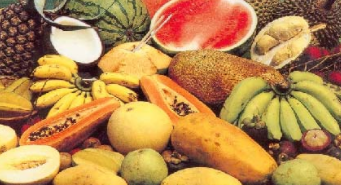The Gracie Diet
The Gracies have spent almost the entire 20th-century fighting. They have never been able to afford, on the day of a fight, to be sick or not prepared. Fortunately, Carlos Gracie, the patriarch of the family and the man behind the clans philosophy, found a solution to this problem. Carlos developed a diet based on three concepts: not poisoning the body, taking care of it and respecting, in one meal, the adequate chemical combination of different types of food.
During his youth, Carlos Gracie ate about everything, and his sensitive organism quickly reacted to such abuse. It didn't take long for him to develop serious health problems. Everything changed, though, when he read an excerpt form the great philosopher Hipocrates ("Let your food be your remedy"), and began to dedicate himself to studying various eating methods, taking harmful foods away from his organism and his menu.
He also noticed, just like a farmer who controls the soils PH before planting the seeds, that the bloods PH is a key element during the digestive process and that it must be kept neutral, which helps the transformation of the food. He observed, then, that a certain combination of foods kept the blood neutral, as opposed to some mixtures that made it acid or alkaline. He brought all his study together and created the eating method known as the Gracie Diet, which went through a careful research and was developed throughout the years, consuming most of the last 50 years of his life.
The diet is composed of several food tables divided in the following groups:
Group A- Animal protein, fats and oils, and vegetables.
Group B- Cereals.
Group C- Sweet fruits.
Group D- Acid foods (in majority fruits).
General guidelines of the diet:
- Foods from group A combine with each other and with one of group B.
- Foods from group C combine with each other and with one of group B.
- Foods from group B do not combine with each other.
- Foods from group D can only be consumed individually.
- Banana and milk are not included in any of the groups since they have chemical combinations of their own.
Group A-
Foods that Combine With Each Other Plus One of Group B
Almond, Artichoke, Asparagus, Avocado, Beets-red, Brazil nuts, Broccoli, Butter, Cabbage, Carrots, Cashews, Cauliflower, Celery, Chicken, Cocoa, Coconut-dried, Corn on the cob, Crab meat, Crabs, Cucumber, Eggplant, Eggs, Endive, Fats-oils, Fish, French beans, Garlic, Green beans, Green Mustard, Green Onions, Green peppers, Hazelnuts, Leeks, Lettuce, Lobster, Meats, Mushrooms, Mussels, Octopus, Olives, Olive Oil, Onion, Oregano, Oysters, Parsley, Peanuts, Peas, Pumpkin, Radishes, Savoy Cabbage, Sesame, Shellfish, Shrimp, Spinach, Squid, Thistle, Tomatoes, Turnip and Walnuts.
Group B-
That Do Not Combine With One Another
Barley, Breadfruit, Chestnuts, Chick peas, Corn flour, Corn-dried, Dried beans, Dried peas, Flower of mandic, all starches and Flour, Oats, Pearl barley, Potato, Rice, Rye, Soybean, Wheat, Macaroni and Lentils.
Group C-
Foods That Combine With Each Other Plus One of Group B, Not Prepared in Fat
The Gracie Diet Apples, Bananas, Cream Cheese, Cottage Cheese, Persimmons, Plums, Dates, Grapes, Guava, Honey, Jaca fruit, Melons, Watermelon, Papaya, Pears, Prunes, Coconuts, Ricota Cheese, Figs, Raisins, Sugar cane, Syrups, Teas of leaves, Lemon peel, Black/herb tea and Coffee/decaf.
Group D-
Foods That Do Not Combine With Each Other Or Anything Else
Apple-Acidic, Apricot, Blackberries, Cider, Cherry, Currants, Curdled milk, Grapes-acid, Grapefruit, Lemon, Loquat, Yogurt, Mango, Peach, Pear-acidic, Plums- acidic, Pineapple, Pomegranate, Orange, Quince, Raspberry, Strawberry, Tangerine and Kefir.
Banana
Combines with: Apples, Cheese, Cream-fresh, Figs-fresh, Grapes-Moschatel, Melons-sweet, Watermelon, Sweet Pears, Prunes-Sweet, Persimmon and all other sweet fruits when fresh.
Does not combine with: Avocado, Butter, Dried fruits, Honey, Olive Oil, Oil + Sugar, Sugar Cane, Syrup/Juice, Syrups and Oils and fat in General (Group B)
Milk
Combines With: All of Group B, Banana raw or baked, Saccharin or similar, Cooked Yolk, Milk derivatives (no curdled milk), Kefir and Yogurt
Does not combine with: All of group A, fruits in general, Egg Whites, Meats, Oily fruits, Olives, Sugar in general, Oils and Fats.
Observations
Egg yolk (raw or cooked), Coconut, Coffee, Brewers yeast, and many varieties of teas are compatible with any food, for they are considered neutral.
Avoid: Sweets, Canned goods, Black pepper, Clove, Cinnamon, Mustard, Pickled foods and Vinegar
Never eat: Pork and derivatives
Bread: to be less fermentable, shall be made out of pure or natural flour and eaten 24 hours after baked. Also, it should be eaten as toast or oven warmed
No Alcoholic beverages
No Smoking
Drinking a glass of water when you get up and before you go to sleep. Important: In order to avoid a chemical conflict, it is essential that meals are at least 4½ hours apart. Do not eat anything between meals.

